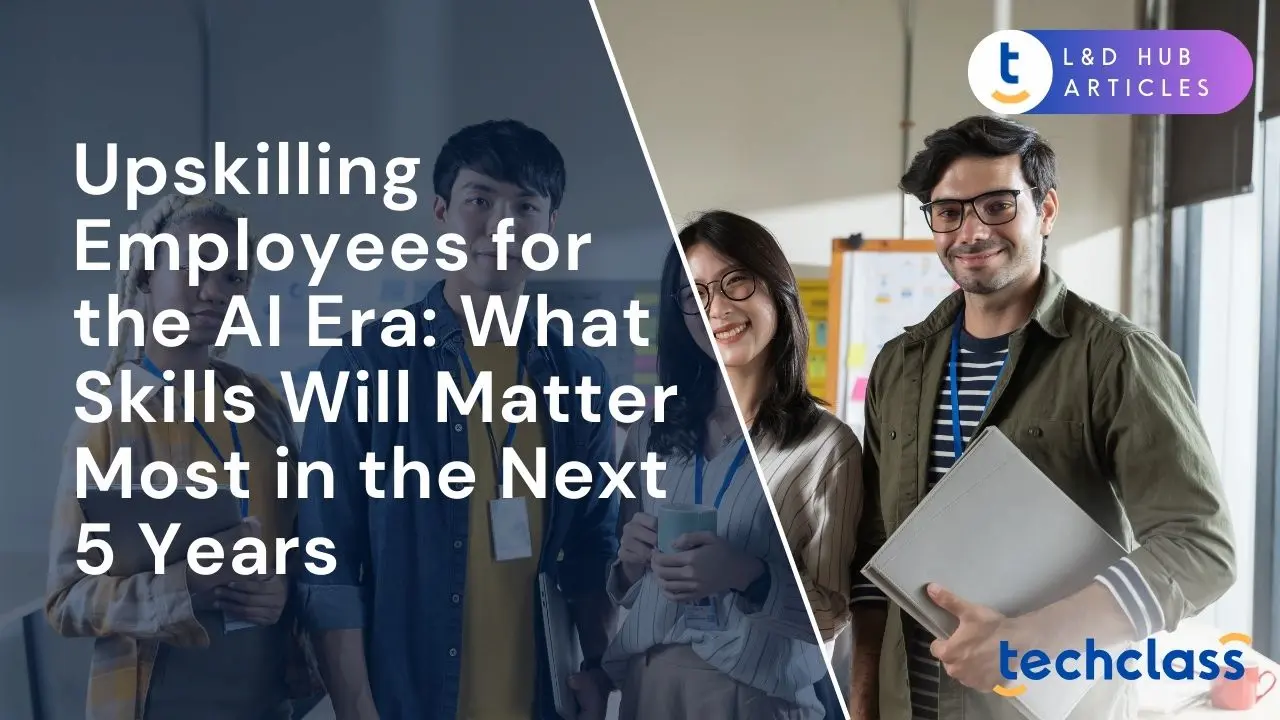
Artificial intelligence (AI) is redefining the workplace at a blistering pace. Tasks once handled by humans are being automated, and entirely new roles are emerging. In this environment, keeping employees’ skills up to date is not just a human resources concern; it’s a strategic imperative for businesses across industries. Studies show that nearly 39% of workers’ core skills will be outdated by 2030, and roughly 59% of the global workforce will require retraining by then. Two-thirds of employers plan to hire for new skill sets, and 85% of companies are prioritizing upskilling their workforce to stay competitive. With 93% of businesses expecting to use AI across their operations in the next five years, organizations that fail to upskill their people risk falling behind. This article explores which skills will matter most in the AI era and how leaders, from HR professionals to CISOs and CEOs, can champion effective upskilling over the next half-decade.
The rise of AI is not a distant future scenario; it’s here, and it’s changing job requirements right now. Automation and AI are expected to eliminate some jobs while radically transforming many others, meaning employees will need to take on new tasks and use new tools. The “half-life” of skills is now less than five years in many fields (and as low as 2.5 years in tech). In other words, about half of what a tech employee knows today will be outdated in just a few years. This accelerated obsolescence of skills is why upskilling has moved to the forefront of business agendas. A recent survey of global companies found that 63% of employers see skill gaps as a major barrier to innovation, and almost all of them are investing more in employee skill development.
For enterprise leaders and business owners, the message is clear: to leverage AI’s potential, your team must be able to work with AI. In fact, 88% of technology leaders believe their AI investments won’t succeed without ramping up workforce skilling. HR professionals are therefore under pressure to identify emerging skill needs and provide training, while CIOs and CISOs recognize that new technologies bring not only productivity gains but also new risks that require skilled mitigation. The cost of not upskilling is steep, companies without a skilled workforce may struggle to implement AI projects, fall behind competitors, or face security breaches due to human error. To support these initiatives, many organizations are turning to structured programs focused on AI Training to help employees understand, apply, and optimize AI technologies across roles. By contrast, organizations that proactively upskill employees can unlock AI-driven productivity while keeping their workforce engaged and future-ready.
In the AI era, technical literacy across the organization becomes non-negotiable. This doesn’t mean every employee must be a software engineer or data scientist, but a baseline understanding of digital technologies, especially AI and data analytics, is crucial. AI literacy is emerging as a vital skill, which includes understanding how AI tools work, knowing their applications and limitations, and being able to interact with AI (for example, formulating effective prompts for generative AI tools). Likewise, data literacy, the ability to interpret data, draw insights, and communicate those insights, is now essential in roles from marketing to operations. Leaders cite AI, data, and cloud technologies as the hardest talent areas to hire for, which is why they’re top targets for upskilling initiatives. By improving employees’ comfort with data analysis and AI-driven software, companies can make better data-backed decisions and fully exploit AI solutions.
Equally important is cybersecurity awareness and skills across the workforce. As businesses adopt AI and move more operations to the cloud, they expand their digital footprint, and with it, exposure to cyber threats. It’s telling that “networks and cybersecurity” skills are among the fastest-growing skill needs worldwide, right behind AI and big data. CISOs and IT leaders are stressing the need for upskilling in security practices: from basic cyber hygiene for all staff (e.g. recognizing phishing or using AI tools securely) to advanced cybersecurity expertise within IT teams. An enterprise is only as secure as its least-informed employee, so training employees on data privacy, security protocols, and the ethical use of AI is now a core part of digital upskilling. By developing stronger in-house cyber talent, organizations can better protect sensitive information in an AI-connected world.
Other technical areas to prioritize include cloud computing (since most AI solutions rely on cloud infrastructure) and general technology literacy. In fact, surveys indicate that tech leaders consider cloud, data, and cybersecurity skills as critical for AI projects to succeed in the next 3–5 years. For employees in all departments, that means gaining familiarity with cloud-based tools, understanding data governance, and being open to adopting new software powered by AI. Companies can support this by providing hands-on training, for example, workshops on using AI platforms or data visualization tools, and by encouraging certifications (such as cloud service certifications or data analytics courses). The bottom line: technical upskilling in the AI era is not limited to IT specialists; it spans the entire organization so that every employee can confidently use new technologies and do their part to keep systems running safely.
While technical know-how is crucial, the “human” skills will matter more than ever as AI takes over routine tasks. In fact, the capabilities that are hardest to automate, creativity, critical thinking, empathy, leadership, are rising to the top of employers’ wish lists. According to the World Economic Forum, analytical thinking is the #1 most sought-after core skill for 2025 (seven in ten companies rank it as essential). This refers to the ability to logically analyze problems, interpret information, and make sound decisions, a skill that remains uniquely human even with AI assistance. Creative thinking is another in-demand skill, as businesses need human imagination to identify new opportunities, innovate products, and devise strategies that differentiate them from algorithmic solutions. AI can generate ideas and patterns, but humans excel at thinking outside the box and applying context, hence companies will prize employees who can pair creativity with AI tools to drive innovation.
Problem-solving and critical thinking go hand-in-hand with creativity. In an AI-driven workplace, employees will often act as problem definers and solution evaluators, using AI as a tool. They must be able to question AI outputs, spot errors or biases, and approach complex challenges from multiple angles. This is why critical thinking and reasoning skills are a focal point of upskilling programs. For example, some firms use scenario-based training or case studies to improve employees’ decision-making skills in situations where AI provides input but a human must interpret and act on it. Data storytelling, the art of translating data analyses into compelling narratives, is another valuable skill that combines technical insight with communication. As AI tools churn out data insights, employees who can weave those insights into a story for stakeholders (through visualization and narrative) will drive better decision-making. Training in data storytelling, visualization software, and business communication can greatly enhance this competency.
Moreover, as AI handles more transactional work, human roles will emphasize interpersonal and leadership abilities. Emotional intelligence (EQ), the ability to understand and manage one’s own and others’ emotions, is paramount for effective teamwork and customer relations. In an age of chatbots and algorithms, customers and employees alike will gravitate toward organizations that still offer a human touch. Upskilling in EQ might involve workshops on empathy in customer service or training managers to coach and communicate with sensitivity. Similarly, collaboration and teamwork skills are critical as organizations become more cross-functional. AI projects often bring together tech experts, business strategists, and frontline operators; success depends on people collaborating across disciplines. Companies should encourage practices that improve collaboration, such as agile project methods or communication tools, and even train teams on how to work effectively in remote or hybrid environments.
Leadership and social influence skills are also in high demand, not just for those with “manager” in their title, but across the board. As AI transforms job roles, employees at all levels are expected to take initiative, guide others through change, and champion new technologies. This could be as simple as an employee leading a knowledge-sharing session on an AI tool they’ve mastered, or as formal as managing a team through a digital transformation project. Upskilling in leadership may include mentoring programs, leadership development courses, and opportunities for high-potential staff to lead pilot projects. And because today’s workforce is diverse and often global, cultural competence, the ability to work well with people from varied backgrounds, is an important facet of modern leadership. Training in diversity, equity, and inclusion (DEI) practices can bolster cultural competence and ensure teams leverage their diverse perspectives effectively. In summary, human-centric skills like communication, creativity, critical thinking, and leadership form the core of an AI-augmented workforce, enabling humans and machines to complement each other’s strengths.
If there is one “meta-skill” that defines the AI era, it is adaptability. The business environment is in constant flux, and job roles evolve rapidly as new technologies emerge. Employees who can quickly adapt to change, learn new tools, and pivot when strategies shift will thrive. In fact, resilience, flexibility, and agility collectively rank among the most critical skills for the coming years. Adaptability means having a mindset that embraces change instead of resisting it. Companies can cultivate this by creating a culture where change is expected and even celebrated, for example, rotating employees through different projects to expose them to new challenges, or recognizing teams that successfully navigated a sudden market shift. Resilience is closely related: it’s the ability to bounce back from setbacks. In an AI-driven workplace, failures (like a project that didn’t deliver the expected results) are inevitable; what matters is that employees learn and persevere. Providing support for mental well-being and creating a psychologically safe environment where experimentation is encouraged can strengthen resilience in your workforce.
Central to adaptability is the concept of lifelong learning. Gone are the days when formal education in early career could sustain a 30-year profession. Now, continuous upskilling and reskilling are the norm. It’s estimated that many workers will need to refresh or upgrade their skills every few years just to keep pace. To embed lifelong learning, organizations should promote a growth mindset, the belief that skills and talents can always be developed. This can be done by offering accessible learning resources (online course subscriptions, internal knowledge portals, etc.) and giving employees time for learning. Some companies have implemented policies like “learning days” each quarter, where employees can take time to attend a workshop or earn a certification. Others incorporate learning goals into performance reviews to signal that developing new skills is just as important as hitting short-term targets.
Critically, the pursuit of knowledge should be woven into daily work rather than treated as a one-off event. As Coursera’s Chief Product Officer noted, the future of learning is “practical skill development, working on real projects, and risk-free experimentation” embedded in the flow of work. Employers can facilitate this by encouraging mentorship (learning directly from peers on the job), enabling job rotations or stretch assignments, and creating sandboxes for innovation where employees can try new tools without fear of failure. This approach keeps skills fresh and curiosity alive. Curiosity and a habit of continuous learning themselves are skills to be nurtured, they drive employees to independently seek out new knowledge, be it mastering a new software feature or staying updated on industry trends. Notably, curiosity and lifelong learning are cited as rising in importance through 2025–2030. By fostering an ethos that “we are all learners,” companies prepare their workforce to continuously adapt to whatever the future brings.
Identifying needed skills is only half the battle, the other half is implementing effective upskilling initiatives. For HR leaders and executives planning for the next five years, a multi-pronged strategy works best to build skills at scale:
By implementing these strategies, businesses create an agile, skilled workforce ready to harness AI technologies. Moreover, effective upskilling boosts employee morale and retention, staff are more likely to stay when they see their employer investing in their growth. It’s a win-win: employees future-proof their careers, and employers gain the capabilities needed to innovate.
Upskilling employees for the AI era is no longer an optional initiative, it is fundamental to enterprise survival and success. The next five years will bring rapid advances in AI, from generative AI tools that can draft content or write code, to intelligent systems that optimize entire business processes. But as advanced as AI will become, it is the human workforce, armed with the right skills, that will determine whether organizations sink or swim in this new era. Companies that invest in their people, teaching them to leverage AI, interpret data, protect against new risks, and collaborate in innovative ways, will gain a competitive edge. Those that neglect upskilling risk a widening skills gap, unable to fully utilize new technologies or adapt to market changes.
For HR professionals, CISOs, and business leaders, the mandate is clear: build a learning organization. This means forecasting what skills will be needed, providing the resources and support for continuous learning, and nurturing a culture that prizes adaptability. It also means recognizing that upskilling is an ongoing journey, not a one-time project. The most future-ready organizations are already shifting from a mindset of “training employees for a role” to “enabling employees to constantly learn and evolve roles.” In doing so, they empower their workforce to not only cope with change but to drive it.
In the AI era, technology may be the catalyst for change, but human talent is the engine that will carry organizations forward. By focusing on the critical skills outlined above, from technical AI and data proficiency to the creativity, critical thinking, and resilience that only humans can provide, enterprises can innovate faster, operate smarter, and truly thrive in the next five years and beyond.
Employees need a blend of technical skills like AI literacy, data analysis, and cybersecurity, alongside human-centric skills such as creativity, critical thinking, emotional intelligence, and leadership. Adaptability and a commitment to lifelong learning are also essential.
With 93% of businesses expected to use AI across operations and many skills becoming outdated within five years, upskilling ensures employees can work effectively with AI, stay competitive, and mitigate risks.
Companies can embed learning into daily work, promote a growth mindset, offer resources like online courses and workshops, and create supportive environments that encourage experimentation and continuous improvement.
Effective strategies include skill assessments, personalized learning paths, blended learning programs, mentorship, leadership support, and partnerships with educational institutions or training providers.
Human-centric skills like creativity, problem-solving, collaboration, and emotional intelligence enable employees to complement AI’s capabilities, lead change, and deliver value in ways machines cannot.


